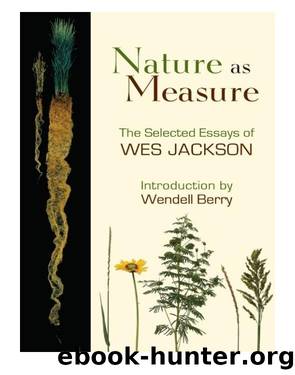Nature as Measure by Wes Jackson

Author:Wes Jackson
Language: eng
Format: epub
Publisher: Counterpoint
Published: 2011-09-14T16:00:00+00:00
Old Salsola
TEN A.M., January 2, 1986. Through the windows of John’s cabin, perched on a low bluff, I look northward over the Cheyenne Bottoms near the Great Bend of the Arkansas River. A strong wind blows from the northwest. Between where I sit and the expanse of water in the bottoms lies a poor pasture, some alfalfa fields, and newly worked sorghum ground. Tumbleweeds of the genus Salsola roll across these fields like purposeful animals migrating to some destination beyond the horizon. They look purposeful anyhow. They look at least as purposeful as the skein of geese that rises out of the bottoms each morning, forming long poor V’s and heading south to shop for breakfast in the fields of shattered sorghum. The wind that propels these weeds and the wingbeat that propels the geese are from the same source: transformed sunlight. Barbed wire fences have stopped some thousands of these weeds, but thousands more roll right over, even where their dead relatives have not accumulated against the wire. A moment ago, one particularly bouncy weed rolled right over a fence, bounding almost like a deer, but with one important difference: a dead Salsola mother will hug the same wire that a live deer clears. Free of the fence so briefly hugged, the cheerful dance of the dead continues. I wonder what is the average number of seeds dropped at each bounce. Surely less than one, but there are lots of bounces in this winter trip of a dead Salsola dispersing her children.
Was it she or the “larger system,” an ancient ecosystem, that prepared her for this day of winter wind: born in June, her branching pattern makes her round by fall, testimony to her ability to remember the past and foresee the coming season with each cell division. But there is more to this globular weed than her shape. For all through the summer, at the base of her stem, she formed an abscission, a knotted ring of cells for easy detachment at ground level in late fall. I don’t know whether she or the larger ecosystem was most responsible for that knotted ring, but the wind does seem a fitting hearse for a last ride to a fence-line cemetery. What other plant could beat Salsola in this respect: that it is in her death that the most energetic and widespread dispersal of her offspring could happen?
Download
This site does not store any files on its server. We only index and link to content provided by other sites. Please contact the content providers to delete copyright contents if any and email us, we'll remove relevant links or contents immediately.
The Lonely City by Olivia Laing(4120)
Animal Frequency by Melissa Alvarez(3755)
All Creatures Great and Small by James Herriot(3517)
Walking by Henry David Thoreau(3234)
Exit West by Mohsin Hamid(3184)
Origin Story: A Big History of Everything by David Christian(3139)
COSMOS by Carl Sagan(2950)
How to Read Water: Clues and Patterns from Puddles to the Sea (Natural Navigation) by Tristan Gooley(2855)
Hedgerow by John Wright(2777)
The Inner Life of Animals by Peter Wohlleben(2767)
Origin Story by David Christian(2684)
How to Read Nature by Tristan Gooley(2666)
Project Animal Farm: An Accidental Journey into the Secret World of Farming and the Truth About Our Food by Sonia Faruqi(2661)
How to Do Nothing by Jenny Odell(2645)
A Forest Journey by John Perlin(2588)
Water by Ian Miller(2584)
The Plant Messiah by Carlos Magdalena(2454)
A Wilder Time by William E. Glassley(2364)
Forests: A Very Short Introduction by Jaboury Ghazoul(2335)
